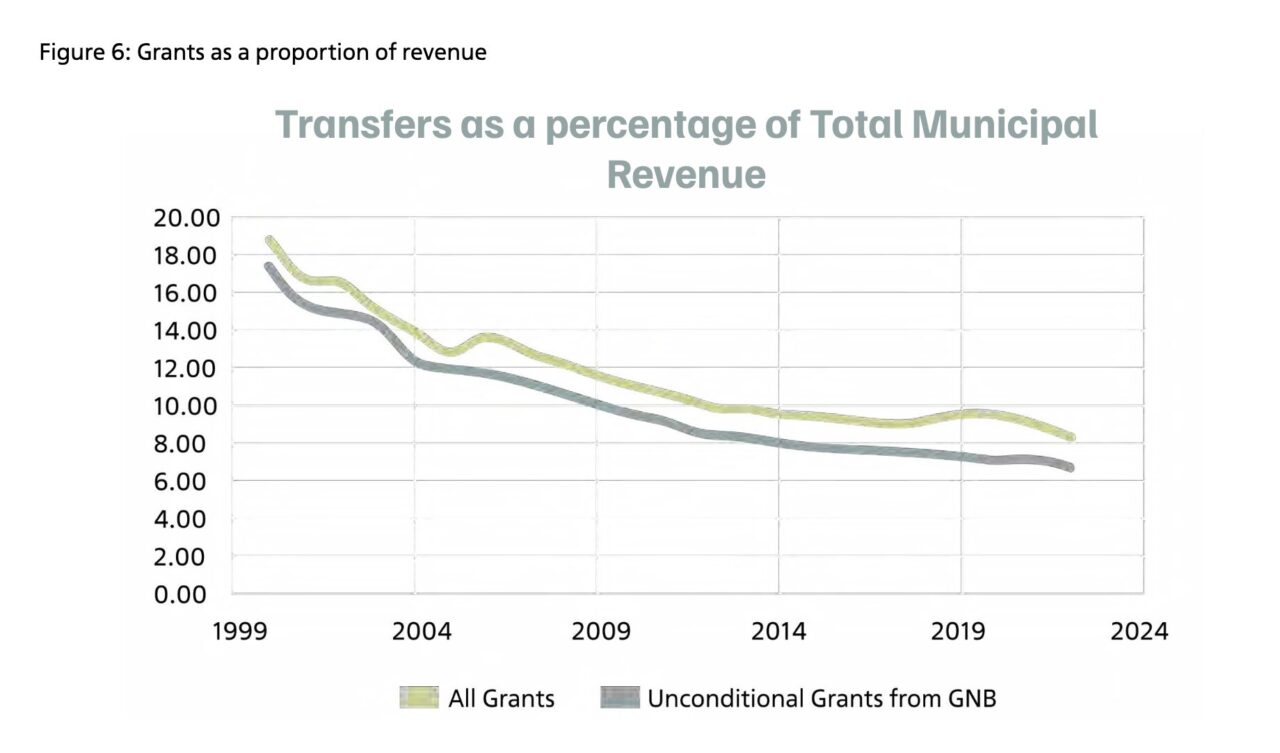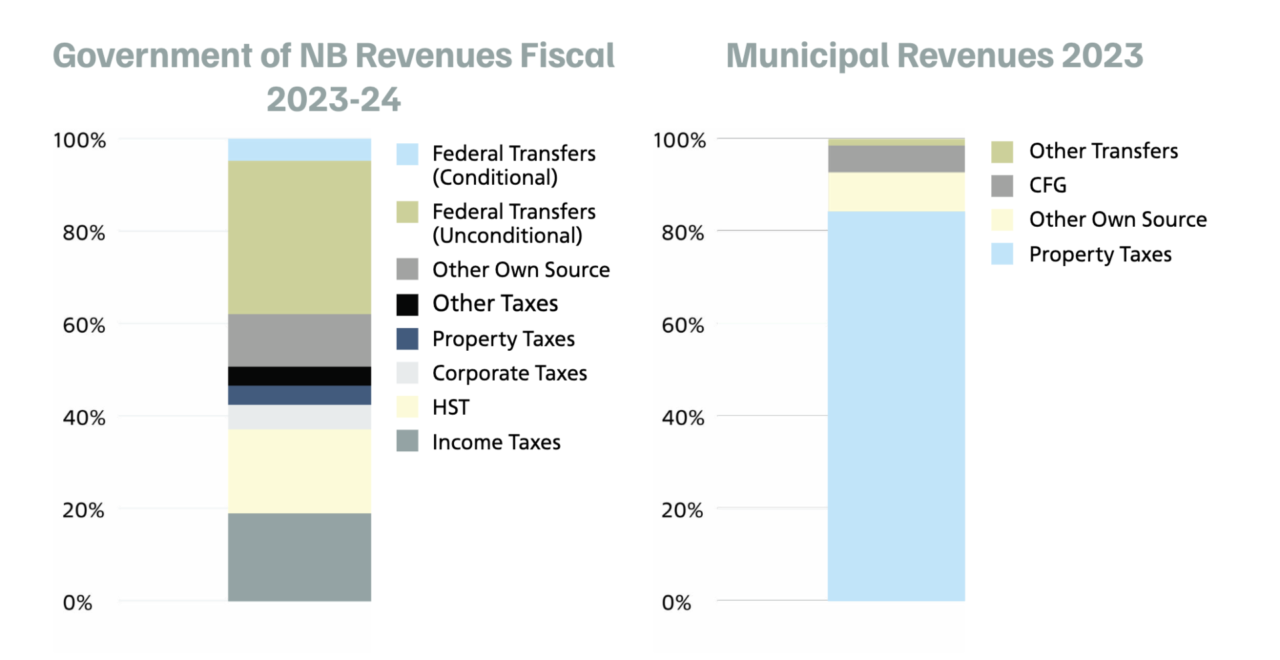
New Brunswick’s municipalities have been asking for changes to the system by which they fund themselves for years, and now a report by a Mount Allison economist is helping them make their case.
In Toward a New Fiscal Framework for New Brunswick Municipalities, Dr. Craig Brett outlines the financial issues facing local governments, and recommends a diversified income for municipalities through an allocation of 1% of the provincial HST.
Brett stopped by CHMA to explain his research and conclusions. You can listen to the full interview here:
“The need for municipal financial reform is in response to things that happened slowly,” says Brett. “It’s one of these things that’s not a problem, not a problem, still not a problem… and all of a sudden it is a problem. Even though it’s the same trends that are going on.”
Brett says there are two big trends that have led the province and its municipalities to this point. “Number one is that the the share of money that municipalities get from the province by way of grants has gone down considerably,” says Brett.
In the 1980s, municipalities got about 40% of their funding from the province, says Brett. Then by the turn of the millennium, that was down to 16-17%, and now municipalities get just 5-6% of their funding from unconditional provincial grants.

“That shortfall has to be made up somewhere,” says Brett. “And for municipalities, that’s essentially the property tax.”
Brett also identified another trend that he says has created a “double whammy” for residential property taxpayers: the faster growth in residential property values versus commercial or industrial property values.
It’s something he didn’t notice when studying the sector 15 years ago, says Brett. In 2000, municipalities got about half their property tax revenue from the residential sector, whereas today they get 62% from residences, he says.
That trend, when combined with a provincial regulation that keeps residential and commercial tax rates in a fixed ratio, means that residential property taxpayers are almost exclusively filling the gap left by dwindling provincial grants.
“Little by little, residences were taking a larger and larger share of the property tax bill,” says Brett. “It’s not that the businesses are paying a lower share than they used to… but residences are paying a lot higher share, and they’re basically backfilling what the what the province isn’t doing anymore.”
Infrastructure gap
Brett’s study also looked into the municipal infrastructure gap: the growing backlog of maintenance and renewals for municipal infrastructure such as buildings, roads, and water systems.
To estimate that, Brett looked at asset management plans for a number of New Brunswick towns and cities and found a $2 billion shortfall. Meeting that shortfall would cost roughly $120 million per year, equal to about 10% of current municipal budgets.
Brett also identified a gap in the province’s efforts at equalization among municipalities, which has been dwindling along with the decline in provincial grants. To deal with both, Brett figures municipalities would need another $200 million in funding each year.
And that’s where one of the report’s key recommendations comes in. Brett suggests using 1 percentage point from the provincial HST to fund municipalities. Since the province collects 10 percentage points in HST, that would mean diverting one tenth of its HST revenue to local governments, amounting to about $225 million, according to the last fiscal year. Brett says about half of that allocation should go towards municipal operating budgets, including a program of equalization, and the other half or more should go towards the infrastructure backlog.
Brett favours the 1% HST solution over simply increasing the provincial grant program because it might prove more stable in the long run. “We’ve had 50 years of having a grant program, and then every year it just kind of gets whittled away,” says Brett. “And so tying it to a particular revenue source kind of prevents that day-to-day death by a million cuts.”

There’s also models of HST revenue-sharing working in two other provinces, says Brett. Both Saskatchewan and Quebec use a set portion of their provincial sales tax to fund municipalities. That makes the 1% HST option something that could be implemented relatively quickly, as long as the provincial government were willing to give up control of roughly $225 million each year.
UMNB commissioned report
Brett’s report comes at the request of the Union of Municipalities of New Brunswick, and the timing is important. With a provincial election happening October 21, Brett has been presenting his report and HST recommendation to all the parties, and the UMNB has been vocal, even hosting a municipal forum with party leaders in Fredericton last Thursday.
“Municipalities want something done,” says Brett. “They feel like the job of municipal restructuring is only half done. The physical stuff is done, but the the money part is just left to drift right now.”
All three parties are espousing some type of municipal fiscal reform, but so far only Green leader David Coon has expressed support for the 1% HST fix. Coon told CHMA that the HST transfer is a good solution to meet the needs of municipalities, but it would have to wait a year or more, so that the province can afford the “generational investments” the Greens are recommending in health care. Coon does support some smaller tweaks to the municipal tax system, including transferring the provincial portion of industrial property taxes to municipalities, and reworking how provincial equalization grants are distributed.
Liberal leader Susan Holt has not signed on to the 1% HST solution, but said in an emailed statement she was committed to a second “fiscal phase” of municipal reform. She said Liberals would overhaul New Brunswick’s property tax system, which “will help municipalities to have more stability and predictability with their budgets.”
Incumbent local government minister and PC candidate Glen Savoie represented the PC party at Thursday’s municipal forum, and like Holt, did not endorse the 1% HST transfer to municipalities. Savoie told those gathered that the fiscal reform his government promised for 2025 would be in place by 2026, if the PCs are re-elected on October 21.
HST cut versus HST transfer?
While the timing of his report right before the election is intentional, says Brett, it is just a coincidence that it comes shortly after Premier Blaine Higgs announced a campaign promise to reduce the HST by 2% over two years. Higgs said in July that if re-elected, the PCs would cut 1% from the HST in the spring of 2025, and then make a second cut in 2026. That would return the HST to its pre-July 2016 level of 13%, back when economists were sounding the alarm over New Brunswick’s debt to GDP ratio, which peaked at just over 40% in 2016.
“The premier made that announcement the same day I came to that conclusion,” says Brett, “like about 12 hours later.”
Brett says his first reaction to the premier’s announcement was “oh dear.” Then he thought, “oh, so maybe the province doesn’t need one of those points to the HST, after all.” His third reaction was “probably the wise one,” says Brett. “I get it. This is all part of of the overall provincial budgeting exercise. We’re trying to figure out the right way to carve up that responsibility for paying for what governments do across different sectors of the economy.”
“What the UNMB wants,” says Brett, “is to make sure that the political parties are at least thinking about this as they’re coming up with their priorities for the election. What happens to the HST revenue, or anything else that the province takes, is going to be determined by what happens on October 21.”
